The consumption of ice cream among Yankees varies inversely with the velocity of the east wind. —Fortune magazine, September 1940
The Original Restaurant Franchise
Started by Howard Deering Johnson in 1925, Howard Johnson’s would become one of the largest franchised restaurant chains in the United States. The restaurants conveniently dotted the turnpikes and new highways of the country. The food wasn’t fancy, but it was delicious and traditional American fare. The restaurants were perhaps best known for their excellent ice cream from which patrons could select 28 different flavors.
The design of the restaurants were easily recognizable from the road by travelers. Orange roofs paired with a large, church-like steeple. A veritable beacon. A port in the storm for hungry, traveling salesmen and families on vacation.
In addition to its remarkable growth over fifty years, perhaps equally incredible is the fact it thrived during the Great Depression only then to face a near-death experience during World War II. However, despite its success, Howard Johnson’s would eventually fade in the face of even hungrier competition from fast food concepts from McDonald’s, Burger King, and others.
Birth of a Franchisor
Howard Deering Johnson was born in 1897 in Dorchester, Massachusetts. Howard’s father was a cigar salesmen who put the family’s finances in dire straits after he had to pay for a large shipment of Puerto Rican cigars that arrived in a ruined state. Thus, at the age of 12, Howard left school to help his dad pay off his debts. Howard first worked at a Boston drugstore for several years. When he turned 16, he became a salesman for his father’s cigar wholesaling business.
In 1921, Howard’s dad died of pneumonia. There was still $30,000 of debt. Howard continued with the cigar business for another three years, but eventually realized the business was shrinking and unsustainable. Howard began working at a small pharmacy. Howard soon borrowed $500 from his mother to buy the place for himself. He reopened the store in September of 1925. There was a soda fountain and he also sold newspapers, cigars, and ice cream. Soon, Howard Johnson’s store was bringing in $30,000 annually.
Delicious Ice Cream
The summer after purchasing his drug store, Howard Johnson spent $300 for a concession to sell ice cream on Quincy Shore Drive facing Wollaston Beach. On the first Sunday in operation, his stand took in $200. The ice cream wasn’t just a nice treat to have on a hot summer day, the quality was superb, thanks to Johnson perfecting a recipe that had nearly double the butter content compared to other ice creams of the day. By summer’s end, his concession stand had earned more revenues than the drug store had earned in two years. Johnson added a few more concession stands at other popular beaches and also added some food to the menu. Johnson was able to pay off all of his father’s debts.
With the success of his drug store and his several concession stands, Johnson had the confidence to open a full-size restaurant in 1929. Johnson got a $50,000 loan from a local bank and the very first Howard Johnson’s restaurant opened in June 1929. It sold traditional New England fare “including roast turkey, steaks and chops, chicken pot pies, baked macaroni and cheese, baked beans and, of course, his delicious twenty-eight flavors of ice cream.”1
Great Depression
Despite stock market crash in October 1929 and the beginning of the Great Depression, Howard Johnson was still able to do good business with his concession stands and his restaurant. However, he wanted to expand his business but credit and capital were sorely lacking. This was a blessing in disguise as the circumstances led Howard towards the idea of franchising.
Howard had a long time friend by the name of Reggie Sprague whom he convinced to open a second Howard Johnson’s restaurant in Cape Cod under a franchising agreement. This was 1935.
The franchising concept proved enormously popular and successful. By the end of 1936, Johnson added another 36 franchised restaurants. At the end of 1939, there were a total of 107 Howard Johnson’s restaurants generating $10.5 million in annual revenues.
World War II
With the advent of World War II, Howard Johnson’s faced a near death experience. There was a shortage of employees and a shortage of patrons. Nearly all commodities were rationed for the war effort. Without gasoline and tires for travel by car, this further curtailed the number of people that could visit a Howard Johnson’s restaurant. As a result, nearly 90% of over 200 restaurants had to close permanently. The way the company was able to survive was by pivoting to being a supplier of prepared food to the military and the government.
After the war, Howard Johnson’s quickly built back up its restaurant business. In 1947 it began the construction of over 200 new restaurants and this time it stretched further towards the South and Midwest. In 1954, the company added a second leg to its growth story: it opened its first motor lodge in Savannah, GA. By 1958, the company had $80 million in revenues coming from 571 restaurants and 43 motor lodges.
HoJo’s Goes Public
In 1959, Howard Deering Johnson stepped down as President of the company and became chairman of the board. His son, Howard Brennan Johnson, took the position of President and leader of the company. Two years later, they offered a little over 40% of their shares to the public in a 1961 IPO.
At this point, Howard Deering’s message to his son was simply to continue growing the business. Howard Deering absolutely did this. From 1958 to 1979, the number of restaurants grew from 571 to 1,054 and the number of motor lodges grew from 43 to 523.
The Tough 1970s
The decade of the 1970s was just an all-around tough one. Howard Deering Johnson passed away in 1972. And although Howard Brennan continued the steady growth of Howard Johnson’s, the growth was nothing compared to new competitors like McDonald’s and Burger King in the fast food category and Marriott in the motel/hotel category. But even in the 1960s, Howard Johnson’s till did more business than McDonald’s, Kentucky Fried Chicken and Burger King combined. This would not last.
Ray Kroc started the first McDonald’s franchise in 1955. Ten years later, he took McDonald’s went public in April of 1965. Between 1965 and 1972, McDonald’s fully caught up to Howard Johnson’s—a business that had existed since 1929—in terms of annual revenues.
McDonald’s bounded past HoJo’s in part because of a more aggressive growth strategy. But there were several other factors at play. One is that McDonald’s had operational advantages that allowed them to take market share. McDonald restaurants had way faster service, a smaller physical footprint, and a menu with relatively less variety. The food at McDonald’s was cheaper and better tasting. On the other hand, HoJo’s had an outdated brand and the leadership had a stronger emphasis on penny-pinching to maintain profit margins at the expense of customer satisfaction. HoJo’s service was much slower and the food relatively more expensive. Customers had started to joke (or complain), “Howard Johnson’s ice cream comes in twenty-eight flavors and its food in one.”
Looking at Howard Johnson’s annual share price range and P/E range, we see that the share hit an all-time high in 1973, but then cratered at the end of 1973 as the Arab oil embargo began. The stock market in general also deflated greatly during this period of high and volatile inflation. Howard Johnson’s share price was pretty much stagnant between 1974 and 1979.
The End of the Orange-Roofed Empire
Despite tepid growth, HoJo’s had nearly $80 million of cash on it balance sheet and no debt at the end of 1979. The P/E ratio had compressed from the high 30s to roughly 10. A British conglomerate, Imperial Group, best known for its tobacco brands Winston and John Player, approached Howard Johnson’s to explore a purchase of the company. The board accepted Imperial’s offer to acquire Howard Johnson’s for $28 per share. This valued HoJo’s at $630 million. EPS for 1979 was $1.55, so Imperial bought it at ~18x earnings.
Imperial bought HoJo’s in 1980, but the acquisition did not work out for them. Imperial sold HoJo’s in 1985 for $314 million to Marriott. Marriott kept 418 company-owned restaurants but immediately sold the franchise system and the company-owned lodges to Prime Motor Inns for $97 million. The various assets of Howard Johnson’s traded hands a number of times over the ensuing decades. The lodging assets were the most valuable, but the restaurant business slowly withered away. The very last Howard Johnson’s restaurant closed in 2022.
Takeaways
“I figured that America really preferred good food, nicely served.”
—Howard Deering Johnson, 1938
Howard Johnson’s was the first great restaurant franchise story in this country’s history. It assiduously concentrated on quality, consistency, and affordability. It became famous for its 28 flavors of high quality ice cream and its thoroughly American food.
Johnson demanded high standards of its franchisees and employees. There is even a story of Johnson having an employee in Connecticut arrested for not adhering to the expiration dates of the food they served. Regarding consistency, Howard Johnson said in an advertisement from the 1940s, “When you get the same kind of sundae in New York that you get in Florida, you are more likely to buy one in Maine.” The branding of the restaurants was also consistent and easily recognizable with its orange roofs.
The success of Howard Johnson’s inspired competitors. For example, HoJo’s directly led to the expansion of Dunkin Donuts. William Rosenburg, founder of Dunkin Donuts, once commented:
“I saw what he (Howard Johnson) was doing with franchising and thought it was such a good idea; he became the impetus for me. The only guy I saw move so fast was Howard Johnson. He was the No. 1 food operation in the early 1950s and had been going since the 1930s.”
Despite its amazing success from the 1920s through the 1960s, Howard Johnson’s eventually ran up against aggressive fast food competition and failed to meet the challenge. It failed to grow and innovate at the speed of McDonald’s. It was too slow to change its branding and restaurant format. It later focused on pinching pennies. It would not use debt to accelerate new concepts or to renovate run-down operations. The quality of Howard Johnson’s food, service, and cleanliness declined in their restaurants and lodges. They lost market share. The very last HoJo’s restaurant closed in 2022.
Although it is wise to reflect on the reasons for the ultimate demise of Howard Johnson’s restaurants, it is just as important to remember its success and celebrate its place in business history. Howard Deering Johnson turned an idea into an amazing reality. Many know him now as the “Father of the Franchise Industry”. The $500 in capital he borrowed in 1925 grew to $630 million by the time Imperial Group acquired the business in 1980, a compounded annual growth rate of 29.1%.
Please Subscribe
If you enjoyed this content, please share and subscribe.
Sources and Further Reading
Listen to the latest Preferred Shares podcast where we talk about Howard Johnson’s, McDonald’s, and Kentucky Fried Chicken.
“Glorified Road Stands Pay”, Business Week, Feb. 17, 1940.
“The Howard Johnson Restaurants”, Fortune, September 1940.
“Putting the HJ Seal on Motels”, Forbes, Oct. 23, 1954.
“Howard Johnson, 75, Founder Of the Restaurant Chain, Dead”, New York Times, June 21, 1972.
“Dry Spell for Howard Johnson”, New York Times, Aug. 6, 1979.
“The Man Who Wants Howard Johnson’s”, New York Times, Sep. 23, 1979.
Crandall, William and John A. Parnell. “Howard Johnson's: Rise and Fall of an American Icon”, Hospitality Review, Volume 19/Issue 2, 2001.
Hoover, Gary. “The First Giant Restaurant Chain: Howard Johnson’s: Rise and Fall”, American Business History Center, Aug. 26, 2021.
Vielkind, Jimmy. “Howard Johnson’s Superfans Can’t Let Go”, Wall Street Journal, June 23, 2022.
Disclaimers
The content of this publication is for entertainment and educational purposes only and should not be considered a recommendation to buy or sell any particular security. The opinions expressed herein are those of Douglas Ott in his personal capacity and are subject to change without notice. Consider the investment objectives, risks, and expenses before investing.
Investment strategies managed by Andvari Associates LLC, Doug’s employer, may have a position in the securities or assets discussed in any of its writings. Doug himself may have a position in the securities or assets discussed in any of his writings. Securities mentioned may not be representative of Andvari’s or Doug’s current or future investments. Andvari or Doug may re-evaluate their holdings in any mentioned securities and may buy, sell or cover certain positions without notice.
Data sources for all charts come from SEC filings, Koyfin, and other publicly available information.
Sammarco, Anthony Mitchell. A History of Howard Johnson's: How a Massachusetts Soda Fountain Became an American Icon (American Palate) (p. 42). Arcadia Publishing. Kindle Edition.


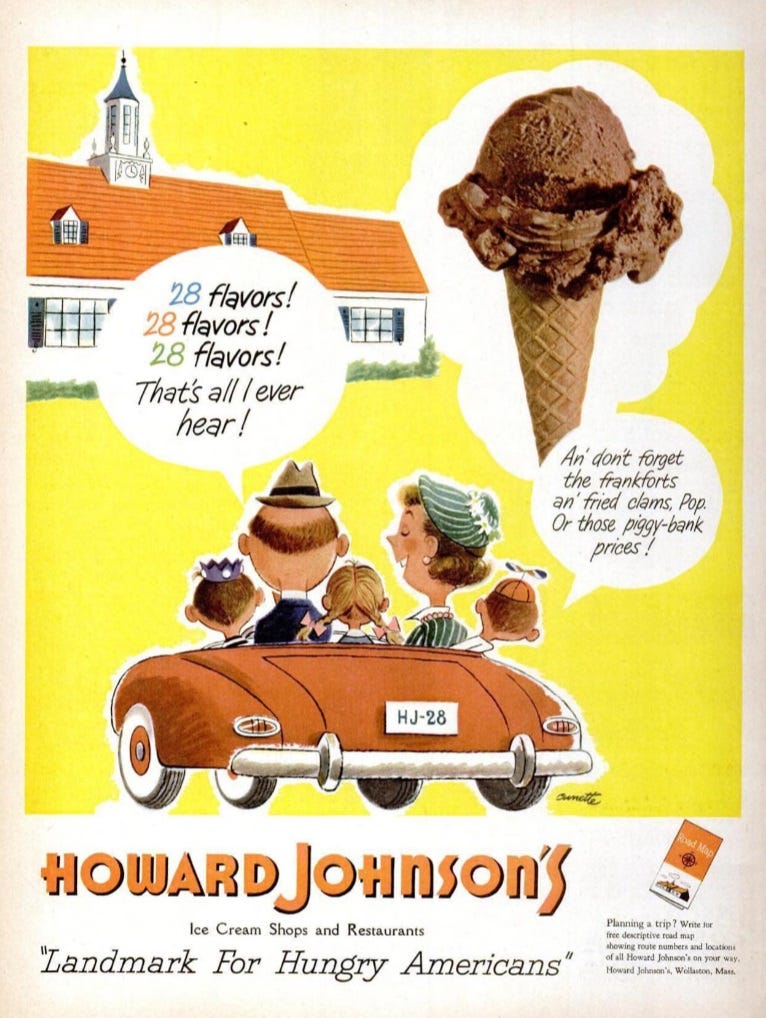
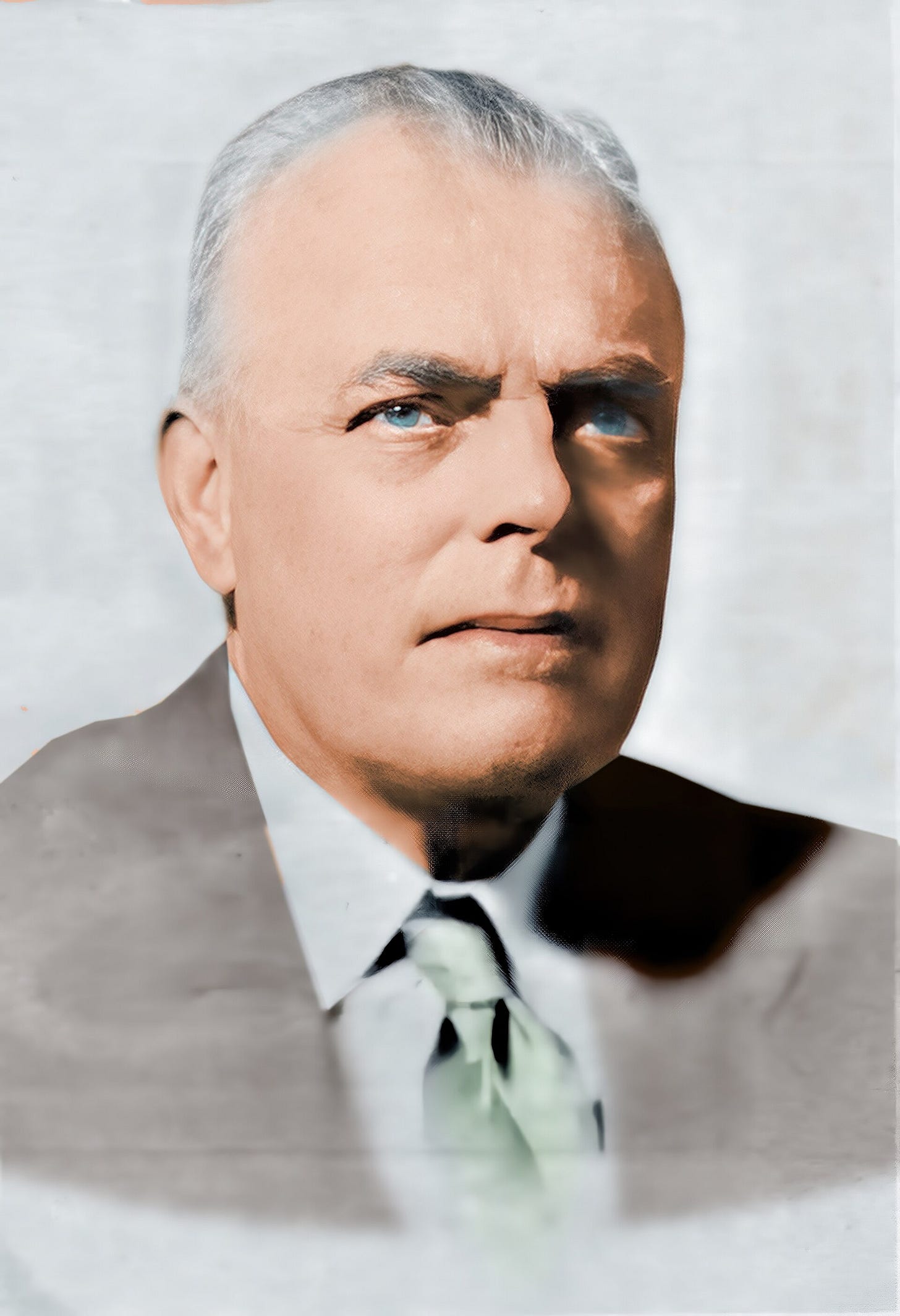
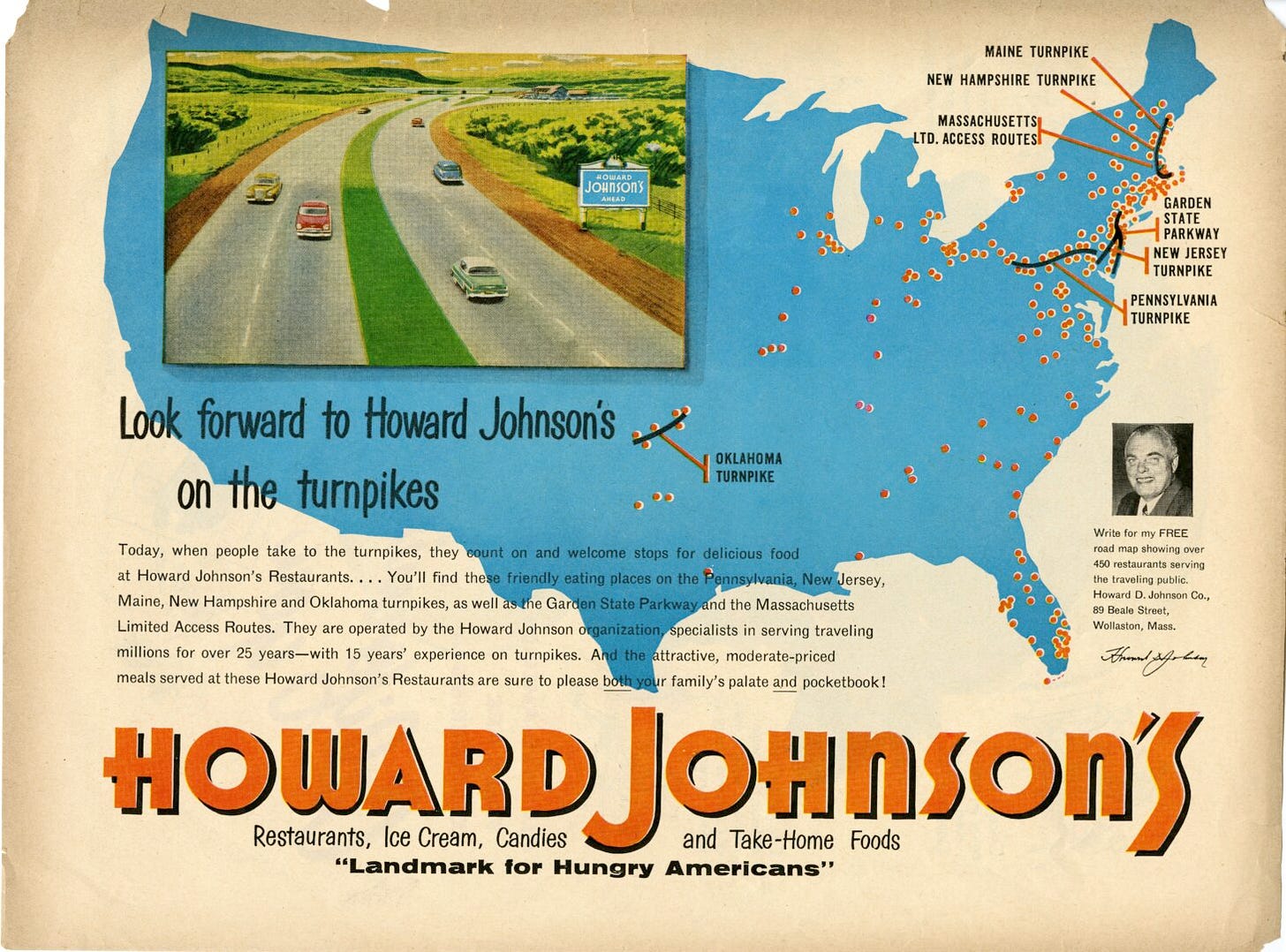
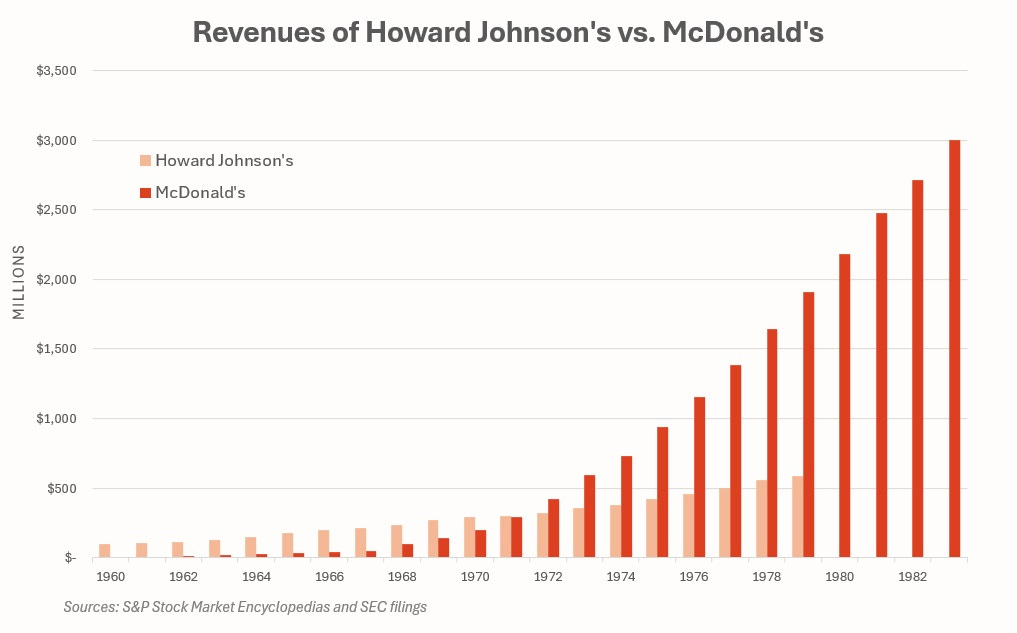




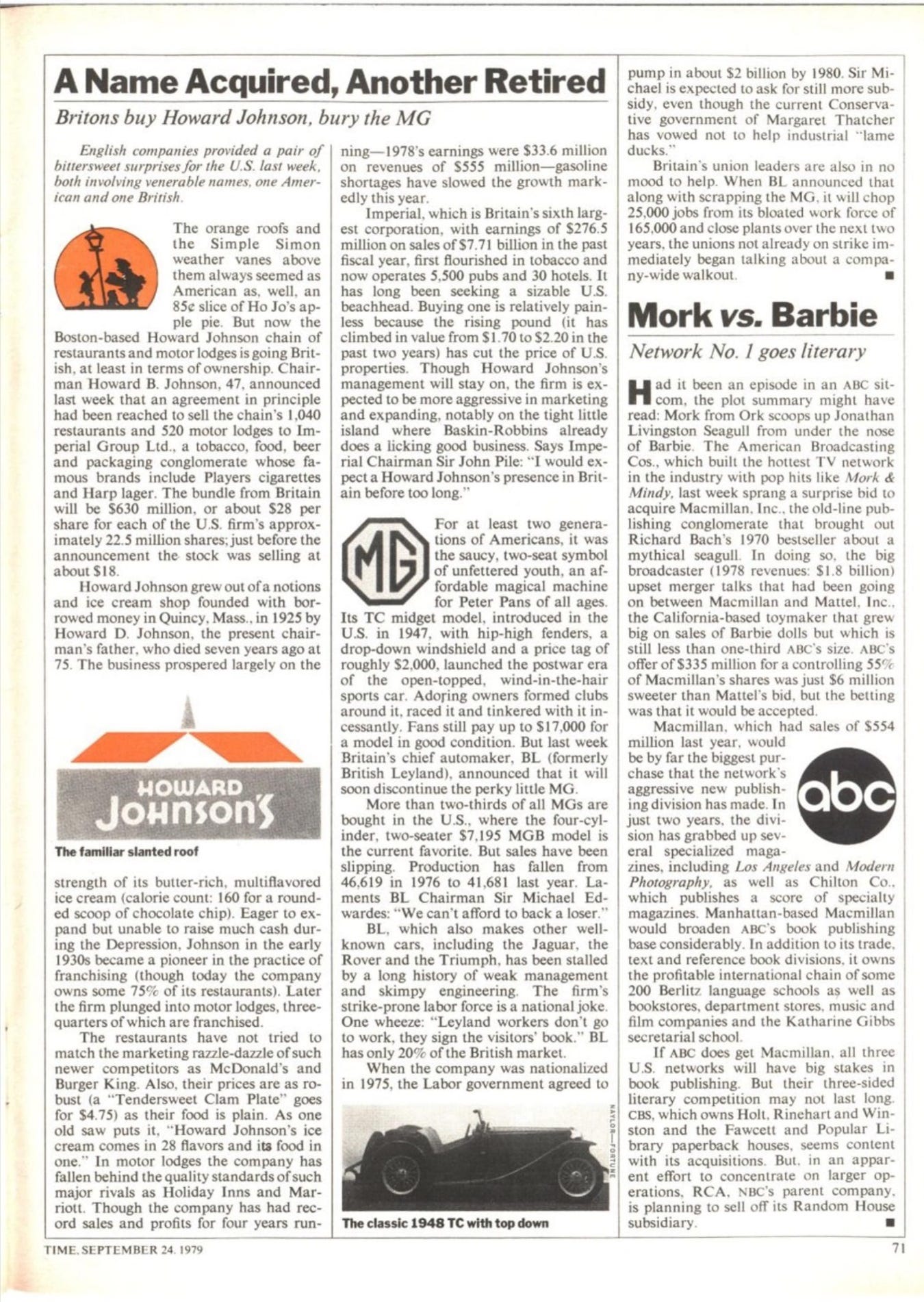

Great read, thanks for sharing!
The book "Ten Restaurants That Changed America" by Paul Freedman has a good chapter on Howard Johnson's. One interesting point the author makes is that Howard Johnson's successful competitors were heavily burger focused whereas Howard Johnson's didn't have much variety in that category. They were known for their hotdogs "Frankforts" so funny to imagine an alternate world where the hotdog holds the place in American culture the burger does.